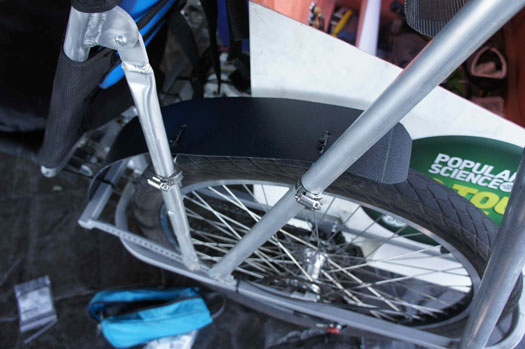

When you drive cross-country, especially at the relatively slow speed of 15 mph, sooner or later you’ll have to deal with some rain. For the first thousand miles of our journey, which carried us through Virginia and Kentucky, we managed to dodge or wait out most of the violent thunderstorms that swept the middle section of the country in June. Our luck ran out in southern Illinois, where we were subjected to 30-plus hours of persistent precipitation ranging from drizzle to deluge.
Our forward fairing and canopy provided some relief from driving rain, but there’s no way to stay completely dry in an open vehicle like ours. Most annoying was the steady stream of water thrown up by the rear tires. I had only myself to thank for that inconvenience, as we’d originally installed a nice-looking pair of bike fenders over the wheels. Unfortunately, the wire mounts used to secure those fenders were not sufficiently rigid to prevent movement as the vehicle lurched on turns and rough roads. This resulted in tire chafe. Less than 400 miles into the trip, I stripped the offending fenders from the frame and decided to run with open wheels. When the hard rains came, the wet roads were showing the folly of my ways.
With no easy way to shop and receive new custom bike fenders while on the road, the next best choice was to improvise. A trip to a local hardware store netted some hose clamps and angle brackets, while foraging in a nearby discard bin turned up a warped but clean plastic garbage can. A few minutes with tin snips turned two mid sections of the can into a pair of rectangular strips that roughly retained their original curvature.
These strips were bent to angle brackets attached to frame uprights, and secured with zip ties. The process of constructing these crude – but ultimately quite effective – fenders brought back college-era memories of the book “Zen and the Art of Motorcycle Maintenance.” At one point in that book, author/narrator Robert Prisig attempts to use slivers of a beer can to shim the handlebar clamps of his friend John Sutherland’s new motorcycle. Sutherland is horrified by the idea of incorporating discarded items into his pride and joy, though Prisig argues that the aluminum can remnants are actually an ideal material.
During the early stages of building our hybrid vehicle, my attitude was more in line with Sutherland, as it sometimes seemed more thought was given to aesthetics than function. Had time permitted, I would have commissioned a pair of custom rear fenders. Now, after several rounds of repairs, upgrades and modifications, I’m perfectly fine using a garbage can as raw materials for fenders. And if they look a bit rough, well, they certainly keep us dry.
